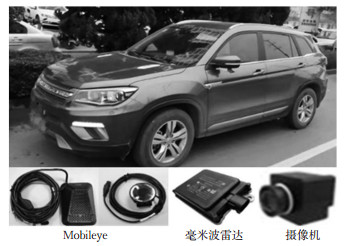Simulation of Vehicle Following Platoons at Cut-in Scenarios Based on Natural Driving Data
-
摘要:
车辆切入是常见的驾驶行为,频繁的变道切入行为影响了通行效率与交通安全。因此,揭示切入场景下的驾驶特性对研究交通拥堵和行驶安全机理具有重要意义。在自然驾驶数据的基础上,根据驾驶人的主观风险感知特性,探究驾驶人的切入行为发生条件,并在期望安全裕度(DSM)模型的基础上,标定了切入场景下的相关参数,根据标定结果进行切入场景下的队列跟驰仿真。仿真结果表明:在仿真区间内,队列的长度、行驶速度以及切入车的切入位置不同会影响队列的稳定性以及队列的调整,当队列长度由4辆变为13辆,速度由5 m/s增至20 m/s,切入车的位置由贴近前后车变为前后2辆车中间时,切入行为对队列的稳定性影响变得越小,队列越容易恢复到稳定状态。
Abstract:Vehicle cut-in is a frequent lane-changing behavior, which has a significant impact on traffic efficiency and safety. Therefore, studying driving behavior at the cut-in scenarios is of great significance for disclosing the mechanism of traffic congestion and driving safety. Based on a natural driving dataset collected for this study, driving conditions of the cut-in behaviors are analyzed based on drivers'subjective risk perceptions. A desired safety margin (DSM)model is used to calibrate the relevant parameters under the cut-in scenario, and a following platoon simulation at the cut-in scenarios is developed according to the calibrated results. During the simulation study, it is found that the differences in platoon length, vehicle speed, and cut-in position all affect the stability and adjustment of the platoon. When the number of vehicles in platoon increases from 4 to 13, and their speed increases from 5 to 20 m/s, and the position of the cut-in vehicle changes from close to the front and rear vehicles to the middle of the two vehicles, it is found that the cut-in behavior presents a reducing impact on the stability of the platoon, which also facilitates the platoon returning to a stable state.
-
Key words:
- vehicle following platoon /
- desired safety margin model /
- Monte Carlo /
- cut-in scenario /
-
-
表 1 切入起始时刻各车辆之间SM值的正态性检验
Table 1. Normality test of SM values between vehicles at the beginning of cut-in
SM值 正态性检验 K-S检验 S-W检验 切入车和目标车道后车 0.134 16 0.200* 0.95 16 0.491 目标车道前后2辆车 0.159 16 0.200* 0.922 16 0.179 切入车和目标车道前车 0.174 16 0.200* 0.91 16 0.117 表 2 切入起始时刻各车辆之间SM值的统计参数
Table 2. Statistical parameters of SM values between vehicles at the beginning of cut-in
SM值 平均值 标准差 中位数 切入车与目标车道后车 0.79 0.059 0.83 目标车道前后2辆车 0.96 0.028 0.95 切入车与目标车道前车 1.08 0.097 0.98 表 3 切入车在切入起始时刻的TH
Table 3. TH of the cut-in vehicles at the beginning of the cut-in
TH /s 第1次 第2次 第3次 第4次 切入车与引导车 1.2 1.6 2.0 2.4 切入车与目标车道后车 2.3 1.9 1.5 1.1 -
[1] ZHAO Chunqing, WANG Wenshuo, LI Shaopeng, et al. Influence of cut-in maneuvers for an autonomous car on surrounding drivers: experiment and analysis[J]. IEEE Transactions on Intelligent Transportation Systems, 2020(99): 1-11. http://ieeexplore.ieee.org/document/8715668 [2] 朱西产, 张佳瑞, 马志雄. 安全切入场景下的驾驶人初始制动时刻分析[J]. 中国公路学报, 2019(32): 262-273+318. https://www.cnki.com.cn/Article/CJFDTOTAL-ZGGL201906027.htmZHU Xichan, ZHANG Jiarui, MA Zhixiong. Analysis of the driver's initial braking moment in a safe cut-in scenario[J]. Journal of China Highway, 2019(32): 262-273+318. (in chinese) https://www.cnki.com.cn/Article/CJFDTOTAL-ZGGL201906027.htm [3] SUN Xiaoyu, ZHU Xichan, ZHANG Kaiyuan, et al. Automatic detection method research of incidents in China-FOT database[C]. 2016 IEEE 19th International Conference on Intelligent Transportation Systems (ITSC), Rio de Janeiro, Brazil: IEEE, 2016. [4] 宋现敏, 金盛, 王殿海, 等. 考虑侧向偏移的车辆跟驰模型[J]. 吉林大学学报(工学版), 2011(41): 333-337. https://www.cnki.com.cn/Article/CJFDTOTAL-JLGY201102009.htmSONG Xianmin, JIN Sheng, WANG Dianhai, et al. Car-following model considering lateral offset[J]. Journal of Jilin University(Engineering Edition), 2011(41): 333-337(. in chinese) https://www.cnki.com.cn/Article/CJFDTOTAL-JLGY201102009.htm [5] LIU Kai, GONG Jianwei, KURT A, et al. A model predictive-based approach for longitudinal control in autonomous driving with lateral interruptions[C]. 2017 IEEE Intelligent Vehicles Symposium(Ⅳ), Los Angeles, CA, USA: IEEE, 2017. [6] LU Xiaoyun, SHLADOVER S. Integrated ACC and CACC development for heavy-duty rruck partial automation[C]. 2017 American Control Conference (ACC), Seattle, WA, USA: IEEE, 2017. [7] HUANG Zhiyuan, ZHAO Ding, LAM H, et al. Using the piecewise mixture model to evaluate automated vehicles in the frontal cut-in scenario[J]. Ann Arbor, 2016(1001): 48+109. http://pdfs.semanticscholar.org/ad90/b2ec548ef52ec000d6bef3ca0f467eeec7ad.pdf [8] 鲁光泉, 王云鹏, 田大新. 车车协同安全控制技术[M]. 北京: 科学出版社, 2014.LU Guannquan, WANG Yunpeng, TIAN Daxin. Vehicle-to-vehicle cooperative safety control technology[M]. Beijing: Science Press, 2014(. in chinese) [9] ZHANG Junjie, WANG Yunpeng, LU Guangquan. Impact of heterogeneity of car-following behavior on rear-end crash risk[J]. Accident Analysis & Prevention, 2019(125): 275-289. http://www.sciencedirect.com/science/article/pii/S0001457519302714 [10] NGODUY D. Effect of the car-following combinations on the instability of heterogeneous traffic flow[J]. Transportmetrica B: Transport Dynamics, 2015(3): 44-58. http://www.researchgate.net/profile/Dong_Ngoduy/publication/265160471_Effect_of_the_car-following_combinations_on_the_instability_of_heterogeneous_traffic_flow/links/5405a1ce0cf2c48563b17263.pdf [11] WANG Yunpeng, ZHANG Junjie, LU Guangquan. Influence of driving behaviors on the stability in car following[J]. IEEE Transactions on Intelligent Transportation Systems, 2019(20): 1081-1098. http://it.ckcest.cn/portal.php?mod=viewaid=3347163 [12] TANAKA M, RANJITKAR P, NAKATSUJI T. Asymptotic stability and vehicle safety in dynamic car-following platoon[J]. Transportation Research Record, 2008(2088): 198-207. http://www.onacademic.com/detail/journal_1000038831711310_4fd6.html [13] TAMPERE C, HOOGENDOORN S, VAN AREM B. A behavioural approach to instability, stop and go waves, wide jams and capacity drop[J]. Transportation and Traffic Theory, 2005(16): 205-228. http://www.mech.kuleuven.be/cib/verkeer/dwn/pub/P2005F.pdf [14] HOURDOS J N. Crash prone traffic flow dynamics: Identification and real-time detection[D]. Minnesota: University of Minnesota, 2005 [15] ZHENG Zuduo, AHN S, MONSERE C M. Impact of traffic oscillations on freeway crash occurrences[J]. Accident Analysis & Prevention, 2010(42): 626-636. http://smartsearch.nstl.gov.cn/paper_detail.html?id=daf8bbfe82db6895b8058d56c9d7d050 [16] CHATTERJEE I, DAVIS G A. Analysis of rear-end events on congested freeways by using video-recorded shock waves[J]. Transportation Research Record, 2016(2583): 110-118. http://www.onacademic.com/detail/journal_1000039933848110_5cb7.html [17] HOOGENDOORN S P, OSSEN S, SCHREUDER M M. Properties of a microscopic heterogeneous multi-anticipative traffic flow model[C]. Transportation and Traffic Theory 2007, London, England: Transportation Research Board, 2007. [18] LU Guangquan, CHENG Bo, LIN Qingfeng, et al. Quantitative indicator of homeostatic risk perception in car following[J]. Safety Science, 2012(50): 1898-1905. http://www.sciencedirect.com/science?_ob=ShoppingCartURL&_method=add&_eid=1-s2.0-S0925753512001270&originContentFamily=serial&_origin=article&_ts=1490768039&md5=28613f618702ec172df41472badbdfa4 -





 下载:
下载:












